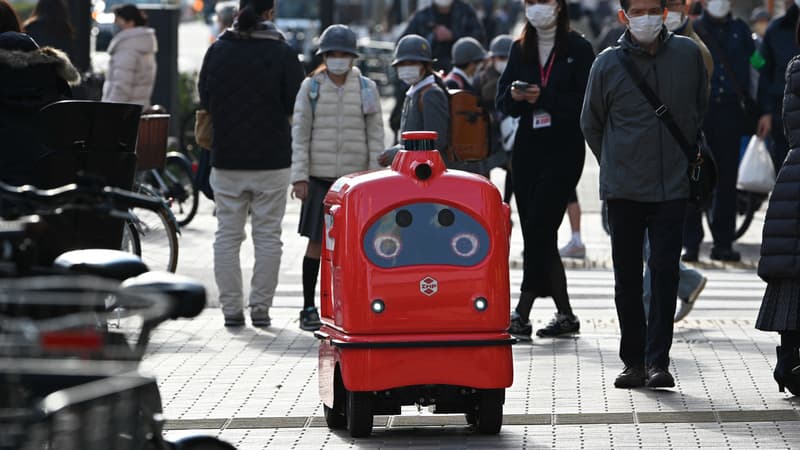“Excuse me, I’m coming through,” chirps a small, four-wheeled, cubical robot moving among pedestrians in a Japanese city. It’s still just a test, but not for long. Starting in April, a revision of the highway code will allow delivery robots to offer their services throughout the country.
But there is still a long way to go before they become widespread, said Hisashi Taniguchi, president of Tokyo-based robotics company ZMP. Robots are “still newcomers to human society” so it is important that they are “humble and kind” to inspire trust, he told AFP. ZMP has been testing its delivery robots in Tokyo for several years in partnership with big groups like Japan Post.
His “DeliRo” robot looks like a big toy, with big, round, expressive eyes meant to soften up passers-by. “All the kids in the neighborhood know his name,” Hisashi Taniguchi exults.
labor shortage
But beyond their cute side, DeliRo and the other delivery robots have an important mission in Japan. Japan’s population is aging (nearly 30% are 65 or older) and many older people live in unpopulated rural areas, where access to basic necessities can be difficult.
The sharp demographic decline is also being felt in cities: home delivery services are facing a labor shortage, while online shopping has skyrocketed since the pandemic.
“The lack of transport workers is a challenge for the future,” says Dai Fujikawa, an engineer at Japanese tech giant Panasonic, which is also testing delivery robots in Tokyo and Fujisawa, southwest of the capital.
Similar robots already exist in other countries such as the UK and China, but Japan is especially concerned about the risk of collision and theft. Japanese regulations impose a maximum speed of 6 km/h, so “the risk of serious injury in a collision is relatively low,” says Yutaka Uchimura, a professor of robotics engineering at Tokyo’s Shibaura Institute of Technology.
But if a robot “comes down from the sidewalk and collides with a car due to a discrepancy between the pre-installed location data and the real environment, it would be extremely worrying,” warns the specialist.
“A Gradual Process”
Panasonic says its “Hakobo” robot can autonomously judge when to stop or navigate around obstacles. And just like his colleague DeliRo, Hakobo isn’t entirely alone: In Fujisawa’s control center, a human simultaneously monitors four robots via cameras.
It alerts automatically if they are “stuck or unable to move due to obstacles,” says Panasonic’s Dai Fujikawa. Humans intervene in this case, as well as in high-risk areas such as intersections, where Hakobo is programmed to send real-time traffic light images to operators and await instructions from him.
So far, trials with Hakobo have involved delivering medicine and food to Fujisawa residents or offering snacks in Tokyo. Sometimes with some commercial chatter: “Another cold day, huh? How about hot drinks?”
“We don’t expect a drastic change in the immediate future, because there are jobs at stake,” Hiroki Kanda, an official at the Ministry of Economy, Trade and Industry (Meti) in charge of promoting delivery robots, told AFP. “I think it will be a gradual process.” Furthermore, “even the most basic task performed by a human can be difficult for a robot to reproduce,” recalls Professor Uchimura.
Source: BFM TV


